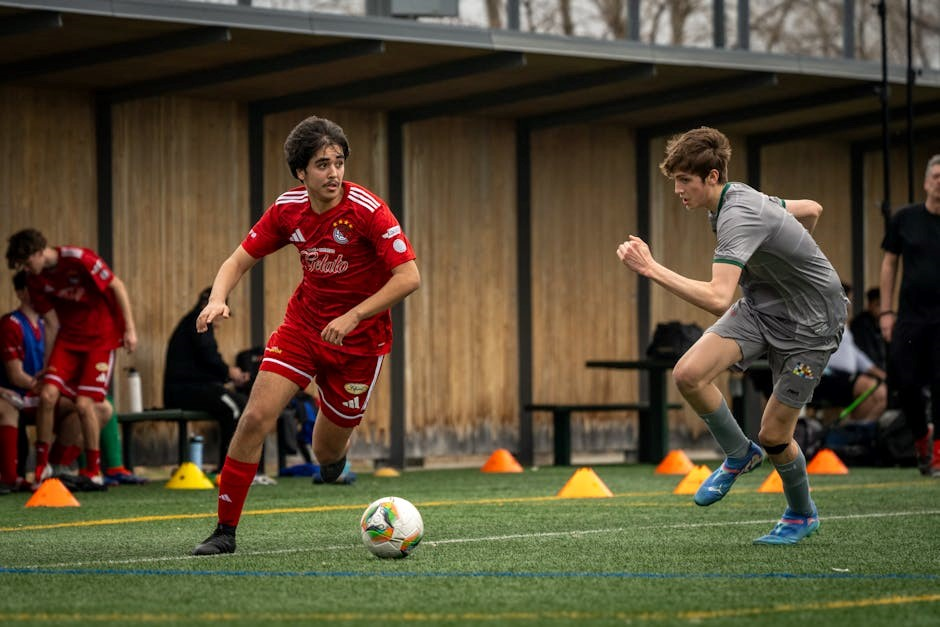The NFHS Football Rules Book is the official guide for high school football, ensuring consistency, safety, and fair play. It outlines rules, updates, and regulations for players, coaches, and officials, promoting sportsmanship and clarity in the game.
Overview of the NFHS and Its Role in High School Football
The National Federation of State High School Associations (NFHS) is the governing body for high school athletics, including football. It establishes standardized rules to ensure fair play, safety, and sportsmanship across the U.S. The NFHS serves 51 state associations, impacting over 19,500 high schools and 12 million students. Its rules promote consistency, enabling smooth competition and clear expectations for athletes, coaches, and officials. The NFHS also provides resources and training to support the growth and integrity of high school football nationwide.
Importance of Adhering to NFHS Football Rules

Adhering to NFHS football rules ensures player safety, fair competition, and consistency across all high school games. These rules promote sportsmanship, clarify expectations for athletes and officials, and maintain the integrity of the sport. Proper enforcement also reduces injuries and disputes, fostering a positive environment for participants and spectators alike. By following NFHS guidelines, schools uphold the values of teamwork, discipline, and respect, which are essential for the growth and development of student-athletes.

Key Updates in the 2024 NFHS Football Rules
The 2024 NFHS Football Rules include revisions to forward fumbles, jersey number visibility, restrictions on mouthguard attachments, and clarifications on the 40-second play clock.
Forward Fumbles Out of Bounds Rule Revision
A significant revision in the 2024 NFHS rules addresses forward fumbles. When a forward fumble goes out of bounds or is ruled out of bounds between the goal lines, the ball is returned to the spot of the fumble. This change prevents an unfair advantage to the fumbling team, ensuring fair play and maintaining game integrity. The revision aligns with safety and competitive balance, providing clearer guidelines for officials and teams alike during such situations.
Jersey Number Rules and Visibility Requirements
The 2024 NFHS rules mandate that jersey numbers must be at least 8 inches tall on the back and 6 inches on the front, with a 1-inch stroke. Numbers must contrast clearly with the jersey color for visibility from 20 yards. Logos or designs must not interfere with number recognition, and there must be space around the NFHS logo to ensure distinctiveness. These requirements ensure player identification and fair play, maintaining consistency across all games for officials, players, and spectators.

Player Conduct and Safety Regulations
Player conduct and safety regulations prioritize fair play, sportsmanship, and injury prevention. Rules address illegal contact, unsportsmanlike behavior, and proper equipment use to protect athletes and maintain game integrity.
Rule 2-29-1: Player Out of Bounds
Rule 2-29-1 defines a player as out of bounds if any body part touches the ground beyond the field’s boundaries. This rule ensures clear determinations of player status during gameplay, maintaining fair play and consistency. Proper enforcement by officials is critical to prevent disputes and ensure safety. The rule references Figure 1-4-2 and aligns with Rule 1-5-1, emphasizing accurate calls for out-of-bounds situations.
Restrictions on Attachments to Tooth and Mouth Protectors
Effective with the 2026 season, Rule 1-5-1d(5)a restricts attachments to tooth and mouth protectors. Items not serving a protective purpose are prohibited to minimize risks and ensure compliance with safety standards. This rule aims to prevent unnecessary distractions and potential hazards, maintaining the integrity of mouth protection. Officials must enforce this rule to uphold player safety and fair competition, as specified in the NFHS guidelines.

Scoring Plays and Down Regulations
The NFHS Rules Book details scoring plays and down regulations, ensuring clear procedures for touchdowns, field goals, and extra points, while maintaining consistent down management protocols.
Spot of the Fumble Rule for Forward Fumbles
The Spot of the Fumble Rule for Forward Fumbles ensures fairness by returning the ball to the spot where the fumble occurred if it goes out of bounds. This revision prevents an unfair advantage to the fumbling team, maintaining competitive balance. The rule applies between the goal lines, with the ball placed at the fumble location for the next play. This change promotes consistency and equity in game outcomes, aligning with the NFHS commitment to player safety and fair competition.
Clarifications on 40-Second Play Clock Exceptions
The 40-second play clock exceptions have been clarified to enhance game flow and fairness. When an officials’ time-out is called for a defensive player’s injury or equipment issue, the play clock is set to 40 seconds. This ensures proper management of stoppages without rushing teams. The rule aligns with NFHS goals of maintaining player safety and efficient game administration, providing clear guidelines for officials and teams to follow during such interruptions.

Equipment and Uniform Standards
The NFHS mandates strict equipment and uniform regulations to ensure player safety and fairness. Helmets must display the NFHS Authenticating Mark, and jerseys must have visible, standardized numbers for identification. Approved footballs are required for all games, and any attachments to tooth and mouth protectors must serve a protective purpose. These rules ensure consistency and prioritize player well-being across all high school football competitions.
NFHS Authenticating Mark and Helmet Logo Requirements
The NFHS requires all helmets to display the Authenticating Mark, ensuring compliance with safety standards. The 2024 rulebook introduced a new format for this mark, enhancing visibility and authenticity. Additionally, helmets must feature the NOCSAE Standard Logo, confirming they meet rigorous safety specifications. Proper placement and visibility of these logos are mandatory, with no alterations allowed. Non-compliant helmets are prohibited from use, emphasizing the NFHS commitment to player safety and uniformity across all high school football games.
Proper Use of Approved Footballs in Games
All footballs used in NFHS-sanctioned games must meet specific standards, ensuring consistency and safety. The 2024 rules specify that footballs must be made of approved materials and meet size and weight requirements. Teams may opt for composition-covered footballs, but they must comply with NFHS guidelines. Proper inflation levels are also mandated to ensure fair play and player safety. Compliance with these standards is non-negotiable, as they are designed to protect athletes and maintain the integrity of the game at the high school level.

Timeout Procedures and Clock Management
Timeouts are crucial for game strategy and player safety. Charged team timeouts occur when requested by players or coaches during a dead ball. Officials may also call timeouts for injuries or equipment issues, ensuring fair play and proper clock management.
Charged Team Time-Outs and Granting Procedures
A charged team time-out occurs when the ball is dead, and a request is made by a player or the head coach (or their designee). The timeout is legally granted under specific conditions, such as during a dead ball situation. If a penalty decision is pending, no timeout is granted until the designated representative makes their choice. Officials ensure proper clock management and fair play by adhering to these procedures. This rule maintains game flow and provides clarity for teams and officials alike during critical moments.
Officials’ Time-Outs for Injuries or Equipment Issues
Officials may stop the clock to address player injuries or equipment issues, ensuring safety and fairness. For defensive injuries or equipment problems, the play clock is set to 40 seconds. This rule prioritizes player well-being while maintaining game flow. Officials’ time-outs are crucial for resolving such incidents promptly, allowing the game to resume seamlessly. These procedures are designed to protect athletes and ensure equitable conditions for all teams involved.
Penalties and Rule Interpretations
The NFHS rules outline specific penalties and interpretations to ensure fair play and safety. State associations serve as the sole interpreters of rules for their member schools.
State High School Associations as Sole Interpreters
State high school associations hold exclusive authority to interpret NFHS football rules for their member schools. They ensure consistent application of rules during competitions, providing clarity and fairness.
Any disputes or questions regarding rule interpretations must be directed to the designated rules interpreter within the respective state association. This ensures uniformity and maintains the integrity of the game at the high school level.
Rules Reminder: Key Penalty Enforcement Guidelines
Consistent enforcement of penalties is crucial for fair play. Officials must apply rules uniformly, ensuring clarity in decisions. Specific guidelines, such as handling defensive injuries or equipment issues, outline when the play clock resets to 40 seconds. Proper communication between officials and coaches is essential for resolving disputes. The rules emphasize maintaining game integrity through accurate penalty calls and clear procedures for enforcement. These guidelines ensure a balanced and respectful competition, aligning with the NFHS commitment to safety and sportsmanship.
Officials and Their Roles
Officials must enforce penalties consistently, ensuring fair play and game integrity. Key guidelines include proper clock management during injuries or equipment issues, resetting the play clock to 40 seconds. Clear communication between officials and coaches is crucial for resolving disputes. Penalties must be applied uniformly, maintaining the spirit of sportsmanship and safety. These guidelines ensure balanced competition, aligning with NFHS’s commitment to fair and respectful gameplay.
Responsibilities of Referees in High School Games
Referees play a crucial role in high school football, enforcing NFHS rules to ensure fair play and player safety. They manage game flow, interpret rules, and make decisions on penalties. Key responsibilities include monitoring player conduct, resolving disputes, and maintaining accurate game records. Referees must communicate clearly with coaches and players, ensuring adherence to rules. Their decisions are final, emphasizing sportsmanship and integrity. Proper training and knowledge of NFHS guidelines enable referees to uphold the game’s standards effectively.
Communication Between Officials and Coaches
Effective communication between officials and coaches is essential for maintaining order and clarity during games. Officials ensure rules are enforced fairly, while coaches may request rule interpretations. Communication must remain professional and respectful, avoiding disputes. Coaches can seek clarification on calls, but excessive arguments may result in penalties. Officials provide necessary explanations without delaying the game. This mutual respect fosters a positive environment, ensuring smooth gameplay and adherence to NFHS standards. Clear dialogue is key to upholding sportsmanship and fair competition.
The Structure of the NFHS Rulebook
The NFHS Rulebook is organized by key concepts like player conduct and ball handling, with visual aids like figures and illustrations for clarity. It serves as a comprehensive resource for understanding high school football regulations.
Organization of Rules by Key Concepts
The NFHS Rulebook is meticulously structured, categorizing rules by critical aspects such as player behavior, equipment standards, and game procedures. This logical arrangement ensures easy navigation, allowing users to quickly locate specific regulations. The book is divided into sections that address distinct facets of the game, making it a user-friendly resource for referees, coaches, and players seeking clear guidance on high school football rules and procedures.
Visual Aids: Figures and Illustrations in the Rulebook
The NFHS Rulebook incorporates detailed figures and illustrations to clarify complex rules visually. These visuals, such as diagrams of penalties or equipment standards, enhance understanding. Figures like 1-4-2 and 1-5-1a provide clear examples of jersey number requirements and helmet logos. Illustrations of out-of-bounds scenarios and fumble spots aid referees in making accurate calls. These tools ensure consistency in rule application, making the rulebook an essential resource for referees, coaches, and players to interpret and apply rules effectively during games.
Resources for Understanding the Rules
Downloadable PDF versions of the NFHS Football Rules Book are available online, offering easy access to rules, updates, and visual aids for coaches, players, and officials to study and apply effectively.
Downloadable PDF Versions of the Rulebook
The NFHS provides downloadable PDF versions of the football rulebook, ensuring accessibility for coaches, players, and officials. These PDFs include detailed rules, updates, and visual aids, making it easier to understand and apply the regulations. The digital format allows for convenient access on various devices, facilitating quick reference during games and practices. Regular updates ensure that everyone stays informed about the latest changes, promoting consistency and fairness across all high school football competitions.

Rules Simplified and Illustrated for Easy Understanding
The NFHS football rules are presented in a simplified and illustrated format, making them easier to comprehend. Visual aids like diagrams and charts clarify complex rules, while clear language ensures accessibility for all users. This approach helps players, coaches, and officials quickly grasp key concepts, promoting better understanding and application of the rules during games. The illustrated format also aids in identifying proper techniques and equipment standards, ensuring safety and consistency across all high school football competitions.
Comparisons with NCAA Rules
The NFHS and NCAA rules differ in specific areas, such as forward fumble handling and jersey number visibility, ensuring distinct governance for high school and college levels.
Key Differences Between NFHS and NCAA Rules
NFHS and NCAA rules diverge in areas like forward fumble handling, where NFHS returns the ball to the fumble spot, unlike NCAA. Jersey number visibility and size requirements also differ, with NFHS emphasizing clear identification. Additionally, NFHS enforces stricter guidelines on tooth and mouth protector attachments, prohibiting non-essential items. The 40-second play clock exceptions vary slightly, with NFHS applying specific conditions for defensive injuries or equipment issues. These distinctions ensure rules align with the developmental focus of high school versus the competitive nature of college football.
Rules Reminders for High School vs. College Football
High school football under NFHS rules differs from NCAA in key areas. For instance, the NFHS requires stricter jersey number visibility and specific helmet logos for safety. Timing rules also vary, with NFHS setting the play clock to 40 seconds during officials’ time-outs for injuries. Additionally, forward fumbles out of bounds are returned to the spot of the fumble in high school, unlike college rules. These reminders help players, coaches, and officials adapt seamlessly between the two levels, ensuring compliance and understanding of the distinct regulations governing each.
Historical Context and Evolution
The NFHS Football Rules Book has evolved over decades, adapting to safety needs, fair play, and performance advancements, ensuring the game remains dynamic while preserving its traditions.
Evolution of NFHS Football Rules Over the Years
The NFHS football rules have undergone significant changes over the years, primarily focusing on enhancing player safety and improving game flow. Recent updates include revisions to forward fumble rules, jersey number visibility, and restrictions on mouthguard attachments. These adjustments reflect the federation’s commitment to addressing contemporary challenges while maintaining the integrity of the sport. By continuously refining its regulations, the NFHS ensures that high school football remains both competitive and safe for all participants.
Significant Rule Changes in Recent Seasons
Recent NFHS football rule changes include revisions to forward fumble handling, mandating returns to the fumble spot. Jersey number visibility standards were tightened, and restrictions on non-functional mouthguard attachments were introduced. These updates aim to enhance player safety, improve game clarity, and maintain fair play. The rules continue to evolve, addressing emerging challenges while preserving the sport’s integrity for high school athletes.

State-Specific Regulations
State high school associations adapt NFHS rules to meet local needs, ensuring compliance while allowing regional flexibility. Each state retains authority to interpret and enforce rules within its jurisdiction.
Role of State High School Associations
State high school associations are the primary governing bodies for interschool athletic programs, including football. They adapt NFHS rules to local needs while ensuring compliance. Each association has the authority to interpret and enforce rules within its jurisdiction, addressing unique regional challenges. Their role includes organizing competitions, training officials, and promoting sportsmanship. By balancing national guidelines with state-specific requirements, these associations maintain consistency and fairness in high school football across the country.
Examples of State-Specific Rule Adaptations
State high school associations often tailor NFHS rules to regional needs. For instance, some states modify practice regulations to address extreme weather, while others adjust equipment standards for safety. Texas, for example, has specific heat acclimatization policies, and Colorado includes altitude adjustments. These adaptations ensure fairness and safety while maintaining the integrity of national guidelines. Such modifications highlight the flexibility within the NFHS framework, allowing states to address unique challenges without compromising overall consistency in the sport.

Education and Training
The NFHS offers downloadable PDF versions of the rulebook and simplified guides, providing coaches, players, and officials with accessible resources to understand and enforce the rules effectively.
Resources for Coaches and Players
The NFHS provides comprehensive resources, including downloadable PDF versions of the rulebook and simplified guides, to help coaches and players understand the rules. These materials are designed to enhance comprehension and application of the regulations. Training programs and educational tools are also available, offering practical insights and clarifications on rule changes. Coaches can access detailed interpretations and examples to ensure proper implementation. Players benefit from clear explanations of rules, enabling them to compete safely and fairly. These resources are accessible online, making it easier for everyone to stay informed and up-to-date.
Training Programs for Referees and Officials
The NFHS offers extensive training programs for referees and officials, ensuring they master the rules and interpretations. These programs include workshops, online courses, and mentoring opportunities. Referees learn about rule updates, game management, and safety protocols. The training emphasizes consistent enforcement of rules and effective communication with coaches and players. Officials also gain access to video tutorials and real-game scenarios to improve their decision-making skills. These resources help referees maintain the integrity and fairness of high school football games nationwide.
Future of NFHS Football Rules
The NFHS continues to evolve rules for enhanced safety, fairness, and engagement. Future updates aim to address emerging trends, ensure consistency, and promote player well-being and competitive balance.
Anticipated Changes for Upcoming Seasons
The NFHS is expected to introduce rule updates focusing on player safety, fair play, and equipment standards. Future changes may include revisions to fumble rules, jersey number visibility, and mouthguard attachments. The 2024 season saw the return of the forward fumble rule, while the 2026 season anticipates restrictions on non-functional mouthguard attachments. These adjustments aim to enhance clarity and safety, ensuring the game remains dynamic and equitable for all participants. The NFHS continues to adapt rules to meet modern challenges and maintain the integrity of high school football.
Committee Efforts to Enhance Player Safety
The NFHS committee prioritizes player safety through rule updates and equipment standards. Recent revisions include restrictions on non-functional mouthguard attachments and clarifications on forward fumble rules to reduce injuries. The committee collaborates with experts to address emerging safety concerns, ensuring rules evolve alongside medical research. These efforts aim to protect athletes while maintaining the game’s integrity, reflecting the NFHS’s commitment to creating a safer environment for high school football players nationwide.

Be First to Comment